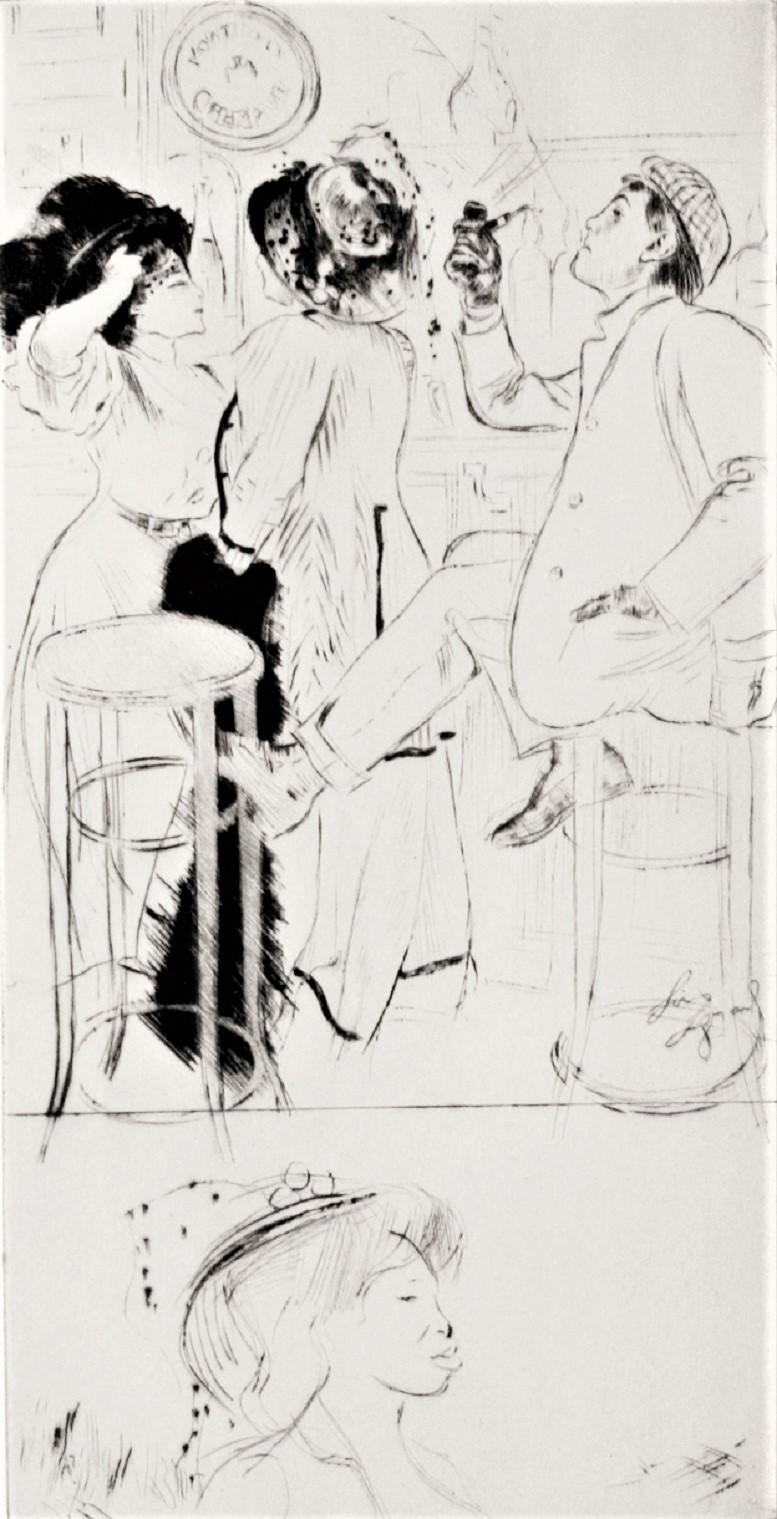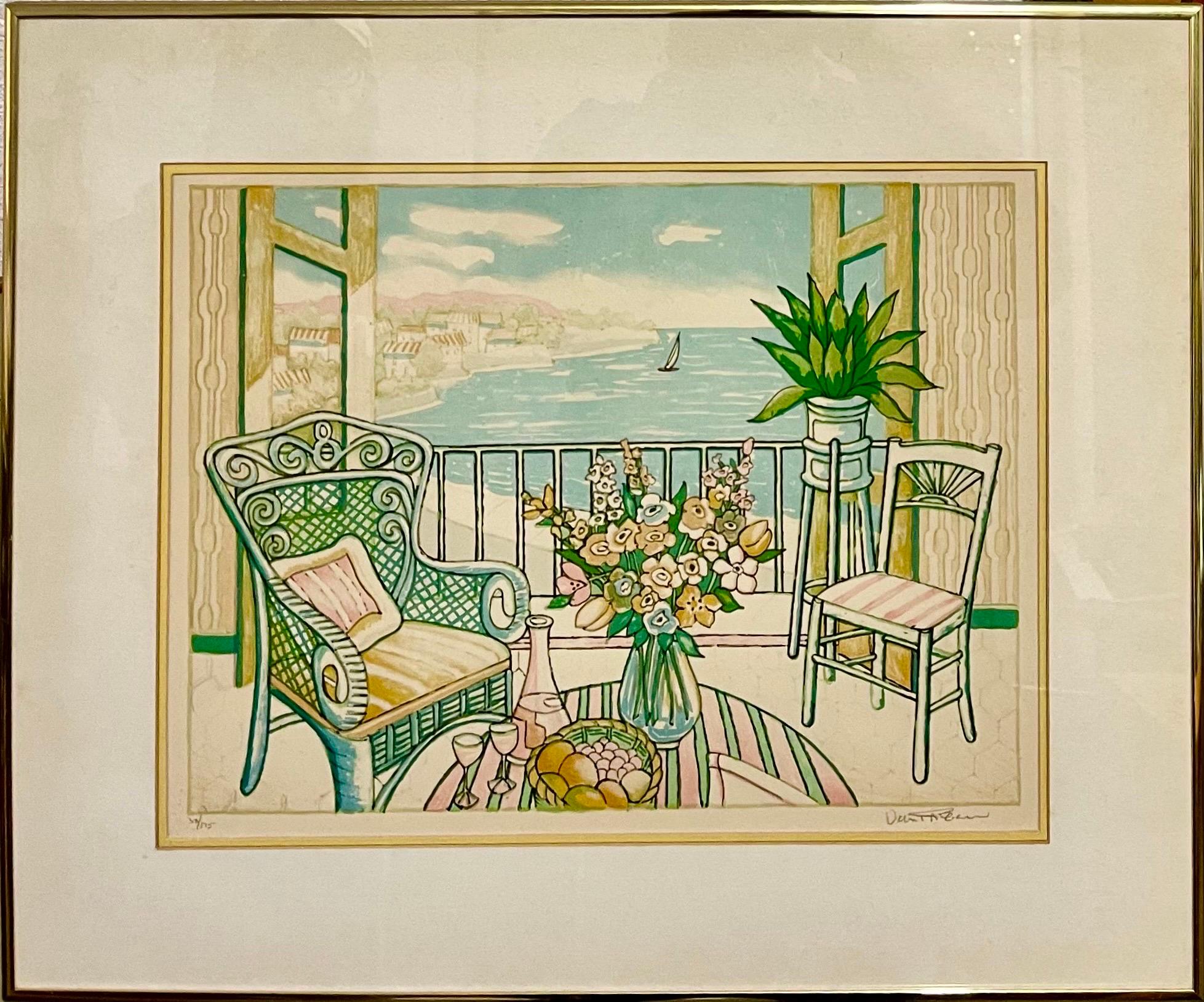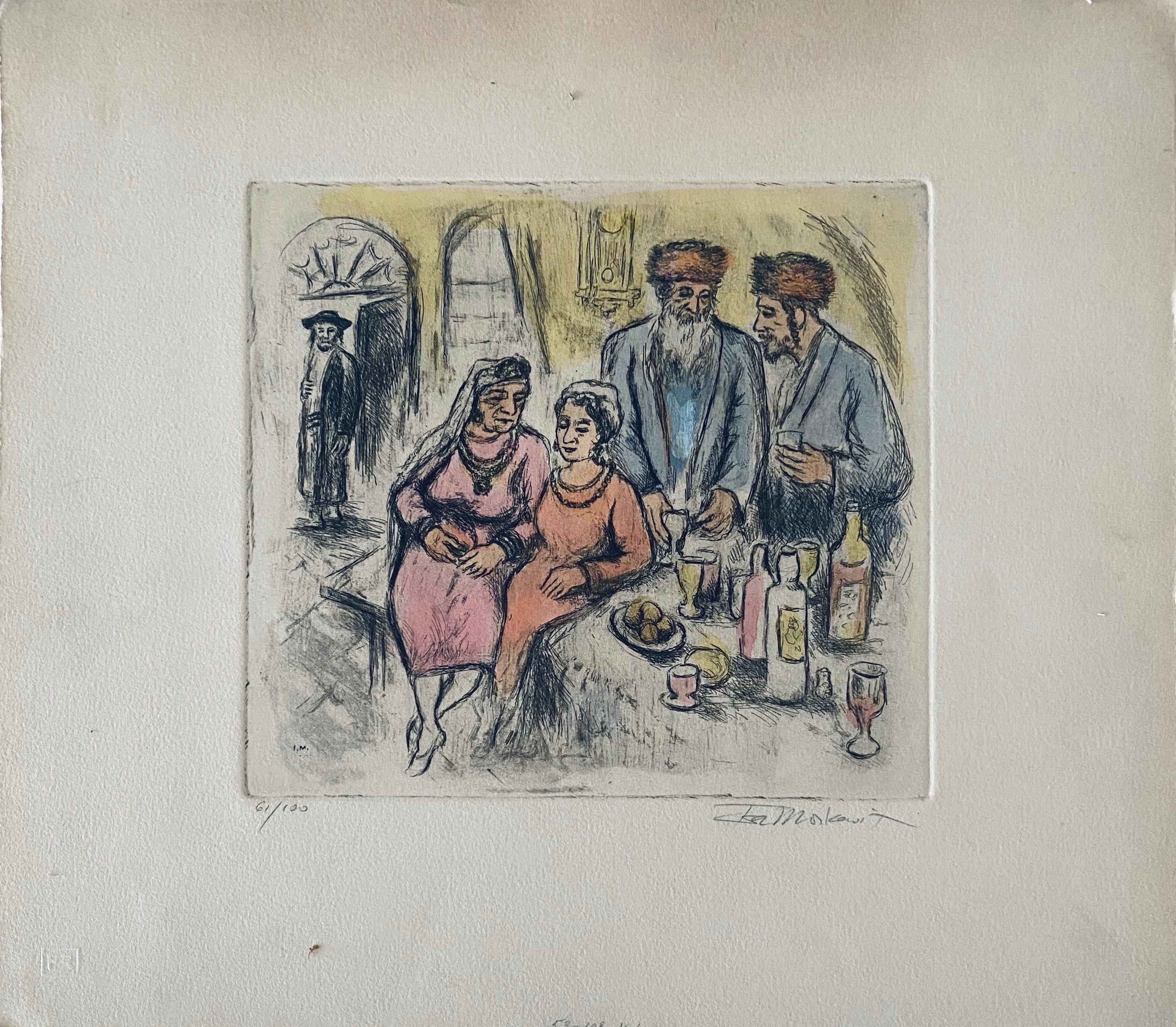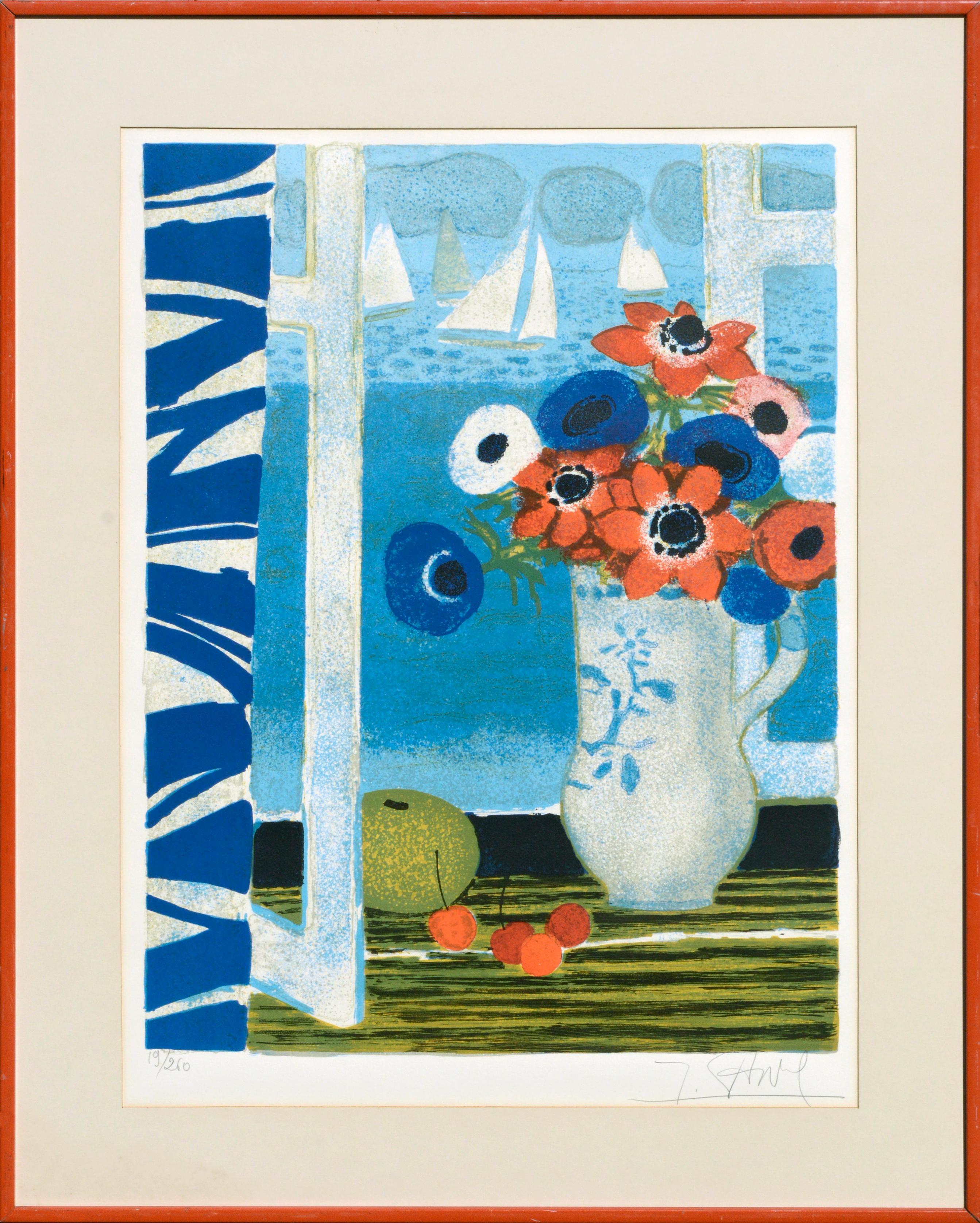Items Similar to Judaica interior scene etching with hand coloring
Want more images or videos?
Request additional images or videos from the seller
1 of 12
Ira MoskowitzJudaica interior scene etching with hand coloring
About the Item
Etching with extensive hand coloring (making it a unique original work of art)
Ira Moskowitz (1912-2001), descendant of a long rabbinical line, was born in Galicia Poland and went with his family to Prague, Czechoslovakia, in 1914. The family remained there until 1927, and young Moskowitz received his first education in Prague's schools. Soon after, his family moved to New York City, and in 1927 Moskowitz became the pupil of Henry Wickey at the Art Students League, having finally resolved his conflict between a passion for drawing and a desire to follow the rabbinical profession of his forefathers. Between 1935 and 1938, he traveled to Israel and to Europe, Paris, France where he studied the works of the old masters, an interest derived from his first teacher and one that eventually led to his active collaboration in 1954 on the four-volume series, "Great Drawings of All Time."
In 1939, Moskowitz made his first trip to Mexico, and stayed for six months. In 1943 he received a Guggenheim Fellowship and moved to New Mexico, where he remained for seven years drawing the Indians and becoming an active member of the Taos-Sante Fe artists group. It was in New York, as a student of Harry Wickey and Jerome Meyers at the Art Students League ( 1928 -32), that Moskowitz honed his talents as an artist. In the mid-to-late 1930s in Mexico, Ira was drawn to the traditions of the native peoples; in Israel, what was then British MandatePalestine he was absorbed with the religious ceremonies of the Hasidic Jews. The prints and drawings Moskowitz created in Mexico in 1941 earned him a Guggenheim Fellowship in 1943.
In 1944, Ira and his wife, the artist Anna Barry moved to Taos, New Mexico. Moskowitz was entranced by New Mexico's light, landscapes, and cultures. By the time Ira arrived there, the region had already attracted Georgia O'Keeffe, Robert Henri, and Leon Gaspard; the Southwest was starting to be recognized as an art center. Moskowitz and his wife became acquainted with Oscar Berninghaus, Andrew Dasburg, Ernest Blumenschein, and Mabel Dodge Lujan, among others.
Inspired by several accomplished printmakers, including Gene Kloss, Doel Reed, John Sloan, and Gustave Baumann, who were living in New Mexico during the same period, Moskowitz began to experiment with lithography, His prints, full of shadow and light, are made up of fine lines and vivid forms. One of the most powerful of these lithographs, Storm, Taos Valley was awarded the First Purchase Prize by the Library of Congress in 1945. Moskowitz's mastery of evoking a mood, as opposed to a straightforward depiction of a scene, is clear.
The former Director of the Cedar Rapids Museum of Art compared Moskowitz to both George Catlin and Alfred Jacob Miller for his ability to so accurately document local Indian cultures -- their daily routines and sacred ceremonies. An early series of drawings he completed on the American Indian were exhibited in 1944 at the Los Angeles County Museum's first show of drawings. Indeed, John Sloan noted that Moskowitz "approaches the Indian not with curiosity, but with friendliness, respect, and awe." That respect was mutual; Ira was often invited by local Indian elders to take part in public ceremonies and private healing rituals.
Today his etchings, lithographs and paintings are included in many major collections in Europe, the United States and Israel. These include the Library of Congress, Washington DC, the Museum of Modern Art, the Metropolitan Museum of Art, the Whitney Museum of American Art, New York, the Carnegie Institute, Pittsburgh, and the Bibliotheque Nationale, Paris.
Religion and Jewish culture played a vital role in Ira Moskowitz's art. Isaac Bashevis Singer once said of Moskowitz; "Ira has recaptured the religious view of God and the world in his works."
This etching was commissioned by the Associated American Artists of New York in a limited edition of 100 impressions.The Associated American Artists commissioned original graphic art (lithograph and etching) from such great masters as Grant Wood, Thomas Hart Benton, Reginald Marsh, Jack Levine, and others.
- Creator:Ira Moskowitz (1912, American)
- Dimensions:Height: 15 in (38.1 cm)Width: 17 in (43.18 cm)
- Medium:
- Movement & Style:
- Period:
- Condition:Some minor edge wear and toning, Please see photos.
- Gallery Location:Surfside, FL
- Reference Number:1stDibs: LU3826191942
About the Seller
4.9
Platinum Seller
These expertly vetted sellers are 1stDibs' most experienced sellers and are rated highest by our customers.
Established in 1995
1stDibs seller since 2014
1,550 sales on 1stDibs
Typical response time: 1 hour
- ShippingRetrieving quote...Ships From: Surfside, FL
- Return PolicyA return for this item may be initiated within 3 days of delivery.
More From This SellerView All
- Vintage Fauvist Color Lithograph Porch Scene Jamaican Artist Van PittersonBy Lloyd Van PittersonLocated in Surfside, FLAfternoon Delight Wicker front porch chair and furniture. Framed 19 X 23 image is 13 x 17. Lloyd van Pitterson was born in Jamaica, West Indies. H...Category
20th Century Post-Impressionist Still-life Prints
MaterialsLithograph
- Judaica interior scene etching with hand coloringBy Ira MoskowitzLocated in Surfside, FLI believe the scene is of a wedding engagement. etching with extensive hand coloring (making it a unique original work of art) Ira Moskowitz (1912-2001), descendant of a long rabbinical line, was born in Galicia Poland and went with his family to Prague, Czechoslovakia, in 1914. The family remained there until 1927, and young Moskowitz received his first education in Prague's schools. Soon after, his family moved to New York City, and in 1927 Moskowitz became the pupil of Henry Wickey at the Art Students League, having finally resolved his conflict between a passion for drawing and a desire to follow the rabbinical profession of his forefathers. Between 1935 and 1938, he traveled to Israel and to Europe, Paris, France where he studied the works of the old masters, an interest derived from his first teacher and one that eventually led to his active collaboration in 1954 on the four-volume series, "Great Drawings of All Time." In 1939, Moskowitz made his first trip to Mexico, and stayed for six months. In 1943 he received a Guggenheim Fellowship and moved to New Mexico, where he remained for seven years drawing the Indians and becoming an active member of the Taos-Sante Fe artists group. It was in New York, as a student of Harry Wickey and Jerome Meyers at the Art Students League ( 1928 -32), that Moskowitz honed his talents as an artist. In the mid-to-late 1930s in Mexico, Ira was drawn to the traditions of the native peoples; in Israel, what was then British MandatePalestine he was absorbed with the religious ceremonies of the Hasidic Jews. The prints and drawings Moskowitz created in Mexico in 1941 earned him a Guggenheim Fellowship in 1943. In 1944, Ira and his wife, the artist Anna Barry moved to Taos, New Mexico. Moskowitz was entranced by New Mexico's light, landscapes, and cultures. By the time Ira arrived there, the region had already attracted Georgia O'Keeffe, Robert Henri, and Leon Gaspard...Category
20th Century Post-Impressionist Interior Prints
MaterialsLithograph
- The MoMA LibraryBy Xiaoze XieLocated in Surfside, FLThis piece is part of an ongoing project entitled "Fragmentary Views" (2001 - Present) by Xiaoze Xie, which is a series of paint-compositions based upon photographs of found newspaper piles. For Xie, stacks of printed pages represent not only cultural memory and the passage of time, but the ways in which history is interpreted and recorded according to various belief systems and political agendas. This is a lithograph, signed, dated 2006, and numbered 28/30 The artist continues his ongoing series of works, Fragmentary Views (2001 to present), which explores the vulnerability and fragmentary nature of historical memory, and the general and superficial perception of world events in the age of ready global media. The paintings depict stacked newspapers where only bits of information are visible-a greater understanding is implicit, but just out of view. "What interests me most is the temporary nature of this mundane object loaded with all-encompassing information of changing daily life: from the front-page news to stock market columns to birth announcements and obituaries. Newspapers are recycled. Life goes on." - Xiaoze Xie In the compressed stacks of newspapers, viewers will notice partial images of fragile life in Baghdad, distraught looks of disbelief of suicide attack victims, the building site of the World Trade Center, campaigns against Fa Lung Gong, and, more recent events that are closer to home. The gravity of these events is muffled as it is embedded in the mundane scroll of daily life. Xiaoze Xie immigrated from the People's Republic of China in 1992, where he was born and studied art and architecture. He has MFA degrees from Beijing and North Texas University, and taught at Bucknell University before assuming his post as Professor of Art at Stanford. His works are in the collections of the Museum of Fine Arts, Houston, the Scottsdale Museum of Contemporary Art and distinguished private collections. Solo Exhibitions Scottsdale Museum of Contemporary Art, AZ Dallas Visual Art Center, TX Modern Chinese Art Foundation, Gent, Belgium Charles Cowles Gallery, New York Gallery Paule Anglim, San Francisco Nicholas Metivier Gallery, Toronto China Art Archives and Warehouse, Beijing Gaain Gallery, Seoul Devin Borden Hiram Butler Gallery, Houston, TX He has participated in numerous group exhibitions including Shu: Reinventing Books in Contemporary Chinese Art at the China Institute Gallery in New York and Seattle Asian Art Museum, and the traveling exhibition Regeneration: Contemporary Chinese Art from China...Category
21st Century and Contemporary Contemporary Interior Prints
MaterialsAquatint
- Judaica Jewish Shtetl Etching Yeshiva Talmudic Study Vintage Chassidic Art PrintBy Paul JeffayLocated in Surfside, FL"Qui a raison?" Chassidic boy, Yeshiva student with open book. Judaica, Jewish scenes from a ghetto. Saul Yaffie, a.k.a. Paul Jeffay, (1898–1957) was a Scottish Jewish artist. Known for his charming French street scenes as well as his judaica work. This is signed in the plate and dated 1931 in the print. This is done in a style similar to the works of the early Bezalel School artists Hermann Struck and Jakob Steinhardt. This lithograph, by artist Paul Jeffay depicts a Judaic Shtetl interior scene with great charm and sensitivity. Saul Yaffie was born in Blythswood, Glasgow on 29 April 1898. His mother was Kate Yaffie (née Karkonoski), and his father, Bernard Yaffie, was a master tailor. Like many Russian Jews, Kate and Bernard Yaffie fled persecution in Russia during a wave of anti-Jewish pogroms triggered by the assassination of Tsar Alexander II in 1881. Saul's father was naturalised as a British citizen by the time that Saul himself was three; a Bernard Yaffie is recorded as living at Abbotsford Place in the old Gorbals, where the young Saul spent the early years of his childhood. The Yaffies were not unique in their situation: the Gorbals was the centre of Scotland's Jewish community and home to a large proportion of Glasgow's immigrants throughout the early 20th century. Over time, there was a movement to some of the more affluent communities in Glasgow, such as Pollokshields and Garnethill, as many Jewish families gradually improved their social and economic situation. Like these, the Yaffies also experienced a time of good fortune, moving to a more agreeable address on Sinclair Drive, Cathcart as Bernard's tailoring business prospered. Saul attended day classes in drawing and painting, modelling, and life drawing at The Glasgow School of Art from 1912 to 1919. During the First World War, he was required to interrupt his studies to serve in the King's Own Scottish Borderers in 1916/17. Although subject to military conscription, Yaffie reached the rank of corporal during his service. Prior to his conscription Yaffie engaged in munitions work, something that was recorded in the GSA's student registers. The post-war economic depression that affected the country during the 1920s, also affected the Yaffie family directly: Bernard Yaffie's business suffered greatly, and the family eventually emigrated to Canada. Saul did not emigrate with his family, choosing instead to stay in Europe, and relocate to jazz age Paris where he continued his artistic practice. Now married, Saul sought to escape persecution in Europe by returning to the UK before the Second World War with his wife, Estusia. The two settled in Manchester, but returned to France after the war. In his memoires ‘Bronze in My Blood’, German-born sculptor Benno Schotz describes a Saul ‘Yaffe’, one of only three other Jewish students who attended The Glasgow School of Art at the time. (Schotz himself was exempt from joining the forces because he was ‘not yet a British subject’, and was engaged in war work in the drawing office of John Brown’s shipyards). On the outbreak of the war, Schotz writes, Yaffie won a poster competition to be displayed in Glasgow tramcars at the beginning of the 1914-18 war – his winning design depicted a woman with a child in her arms, fleeing from a fire behind her. While on leave from service, the young Saul told Schotz he had briefly been stationed in the same unit as Jewish American sculptor Jacob Epstein. This was most likely the 38th Battalion of the Royal Fusiliers, also known as ‘the Jewish Legion’, one of five Jewish battalions raised during WW1. ‘He told me how incongruous it was’, remembers Schotz, ‘to See Epstein scrubbing the floor of their hut, with a large diamond ring on his finger’. His work is included in the collection of the Ben Uri Museum in London along with Lucian Freud, David Bomberg, Mark Gertler, Josef Herman, Jankel Adler, Feliks Topolski...Category
20th Century Expressionist Interior Prints
MaterialsEtching
- Judaica Jewish Shtetl Etching Hasidic Rabbi at Study Vintage Chassidic PrintBy Paul JeffayLocated in Surfside, FLOlder Chassidic rabbi learning with open book, Judaica, Jewish scenes from a ghetto. Saul Yaffie, a.k.a. Paul Jeffay, (1898–1957) was a Scottish Jewish artist. Known for his charming French street scenes as well as his judaica work. This is signed in the plate and dated 1931 in the print. This is done in a style similar to the works of the early Bezalel School artists Hermann Struck and Jakob Steinhardt. This lithograph, by artist Paul Jeffay depicts a Judaic Shtetl interior scene with great charm and sensitivity. Saul Yaffie was born in Blythswood, Glasgow on 29 April 1898. His mother was Kate Yaffie (née Karkonoski), and his father, Bernard Yaffie, was a master tailor. Like many Russian Jews, Kate and Bernard Yaffie fled persecution in Russia during a wave of anti-Jewish pogroms triggered by the assassination of Tsar Alexander II in 1881. Saul's father was naturalised as a British citizen by the time that Saul himself was three; a Bernard Yaffie is recorded as living at Abbotsford Place in the old Gorbals, where the young Saul spent the early years of his childhood. The Yaffies were not unique in their situation: the Gorbals was the centre of Scotland's Jewish community and home to a large proportion of Glasgow's immigrants throughout the early 20th century. Over time, there was a movement to some of the more affluent communities in Glasgow, such as Pollokshields and Garnethill, as many Jewish families gradually improved their social and economic situation. Like these, the Yaffies also experienced a time of good fortune, moving to a more agreeable address on Sinclair Drive, Cathcart as Bernard's tailoring business prospered. Saul attended day classes in drawing and painting, modelling, and life drawing at The Glasgow School of Art from 1912 to 1919. During the First World War, he was required to interrupt his studies to serve in the King's Own Scottish Borderers in 1916/17. Although subject to military conscription, Yaffie reached the rank of corporal during his service. Prior to his conscription Yaffie engaged in munitions work, something that was recorded in the GSA's student registers. The post-war economic depression that affected the country during the 1920s, also affected the Yaffie family directly: Bernard Yaffie's business suffered greatly, and the family eventually emigrated to Canada. Saul did not emigrate with his family, choosing instead to stay in Europe, and relocate to jazz age Paris where he continued his artistic practice. Now married, Saul sought to escape persecution in Europe by returning to the UK before the Second World War with his wife, Estusia. The two settled in Manchester, but returned to France after the war. In his memoires ‘Bronze in My Blood’, German-born sculptor Benno Schotz describes a Saul ‘Yaffe’, one of only three other Jewish students who attended The Glasgow School of Art at the time. (Schotz himself was exempt from joining the forces because he was ‘not yet a British subject’, and was engaged in war work in the drawing office of John Brown’s shipyards). On the outbreak of the war, Schotz writes, Yaffie won a poster competition to be displayed in Glasgow tramcars at the beginning of the 1914-18 war – his winning design depicted a woman with a child in her arms, fleeing from a fire behind her. While on leave from service, the young Saul told Schotz he had briefly been stationed in the same unit as Jewish American sculptor Jacob Epstein. This was most likely the 38th Battalion of the Royal Fusiliers, also known as ‘the Jewish Legion’, one of five Jewish battalions raised during WW1. ‘He told me how incongruous it was’, remembers Schotz, ‘to See Epstein scrubbing the floor of their hut, with a large diamond ring on his finger’. His work is included in the collection of the Ben Uri Museum in London along with Lucian Freud, David Bomberg, Mark Gertler, Josef Herman, Jankel Adler, Feliks Topolski...Category
20th Century Expressionist Figurative Prints
MaterialsPaper, Etching
- Skowhegan Exterior, American Modernist Abstract EtchingBy Robert A. BirmelinLocated in Surfside, FLBorn in Newark, New Jersey, Robert Birmelin became a professor of fine arts at Queens College in New York, and is known for paintings that magnify through texture the realism of natu...Category
20th Century American Modern Interior Prints
MaterialsEtching
You May Also Like
- SportsmenBy Louis LegrandLocated in Storrs, CTSportsmen. 1908. Etching and drypoint. Exsteens 271.i/ii. 11 1/4 x 5 3/4 (sheet 17 3/8 x 12 1/4). Series: Les Bars. From the first state edition of 30 proofs with the remarque sketch...Category
Early 1900s Post-Impressionist Figurative Prints
MaterialsDrypoint, Etching
- Tavern - Etching by Marcel Gromaire - 1952By Marcel GromaireLocated in Roma, ITTavern is a black and white etching on paper, realized in 1952 by Marcel Gromaire (1892-1971). Monogrammed on plate on the lower left corner. Good conditions except for some foxing...Category
1950s Post-Impressionist Figurative Prints
MaterialsEtching
- Flowers and Fruit in Front of the Window Still Life- School of ParisBy Yves GanneLocated in Soquel, CABrightly colored lithograph still-life by Yves Ganne (French, b. 1931). Signed "Y. Ganne" in the lower right corner. Numbered "19/260" in the lower left corner. Presented in a tan ma...Category
Late 20th Century Post-Impressionist Still-life Prints
MaterialsPaper, Ink, Screen
- "La Conversation" Large original lithographBy Jean-Pierre CassigneulLocated in San Francisco, CAThis art work titled "La Conversation" 1991 is an original color lithograph on wove paper by French artist, Jean Pierre Cassigneul, born 1935. It is h...Category
Late 20th Century Post-Impressionist Figurative Prints
MaterialsLithograph
- View on the Artist Workshop - Stone lithograph - Mourlot 1982By Jules CavaillesLocated in Paris, FRJules CAVAILLES View on the Artist Workshop Original stone lithograph in colors (printed in atelier Mourlot) Numbered / 200 On Arches vellum 76 x 56 ...Category
1980s Post-Impressionist Interior Prints
MaterialsLithograph
- Model : Sweet Day at Home - Original Lithograph Handsigned and N° (Mourlot)By Alfred DefossezLocated in Paris, FRAlfred Defossez Interior scene, 1973 Original lithograph (Mourlot workshop) Handsigned in pencil Justified HC On Japan paper 76 x 54 cm (c. 29,9 x 21,2 inch) Very good condition, s...Category
1970s Post-Impressionist Interior Prints
MaterialsLithograph
Recently Viewed
View AllMore Ways To Browse
Post Modern Interiors
Vintage Inspired Interiors
Georgian Interior
Etching Library
Impressionist Etching
Four Etching
Roberts Etching
20th Century Etching Lithograph
Mexican Etching
Etching 2001
Judaica Modern
Modern Judaica
Jewish Etching
European Judaica
Etching New York 1928
Reed Thomas
Art Inspired By Religion
Etching Indian



